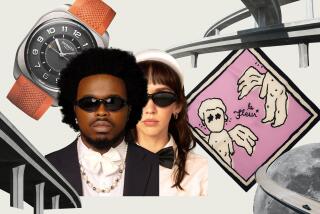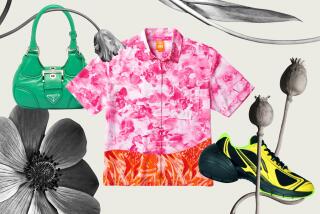Skirt Creates Style Craze -- but What to Call It?
This summer’s must-have fashion item is a style of skirt that has everything going for it -- except maybe a name that everyone can agree on. Indian? Prairie? Gypsy? Bohemian? Bollywood?
By whatever name, the flouncy, colorful skirts inspired by fashions in India have had manufacturers and retailers rushing to keep up with demand.
Miss Chievous Inc., which set up shop in downtown Los Angeles in November, started making the skirts just as the Indian fashion trend was about to explode. By springtime, retailers couldn’t get enough of the skirts, and the fledgling business was filling racks at Nordstrom, Macy’s, Robinsons-May and Charlotte Russe.
“I knew they were going to be huge,” said Staci Daniels, co-owner and designer at Miss Chievous. “It was something new that you didn’t have in your closet that was easy to wear.”
Since then, the skirts have swished past shorts and crop pants to become the summer’s big hit. And they are expected to be a popular back-to-school purchase as well, manufacturers say.
One key to the skirts’ appeal is that a matchstick figure is not required to wear them well.
“If you have hips, if you don’t have hips, if you’re tall or thin, everybody looks good,” said Andrew Assael, co-owner of clothing maker Planet Gold Inc. in New York, which has sold 3 million of the skirts this year and calls its hot-off-the-sewingmachine versions St. Tropez skirts.
Elementary schoolteacher Jenny Geffner, 26, was eyeing Indian-style skirts recently at Harari on Robertson Boulevard in Los Angeles, where they were paired in a window display with shawls, shrugs and even a camouflage jacket.
“They’re fun,” said the Sherman Oaks resident, who already owned seven of the swingy garments. “I wear them every day.”
Miss Chievous said it had piled up nearly $8 million in sales in the last four months, much of it attributable to the skirts. In November, the company had five employees: the co-owners, an accountant, a design assistant and a customer service rep.
The payroll has since grown to 31, including product developers, salespeople and warehouse workers.
“We really got lucky,” Daniels said.
And the company is not alone. Clothing makers from L.A. to New York say they are cashing in on one of the hottest trends in women’s fashion, a craze that also includes other Indian styles, such as tunics, beaded belts and sparkly shoes.
Perfectly poised to profit, Artesia’s Little India neighborhood has seen an influx in non-Indian shoppers who come to buy clothes and end up spending money at other businesses as well, said Mala Malani, owner of Sona Chaandi, where the least expensive skirts sell for $9 and fancy offerings go for as much as $75.
“Everybody’s benefiting here,” said Malani, who estimates that her sales have tripled in a year. “The restaurants are benefiting, the jewelry stores.”
Plays and movies -- such as “Bride and Prejudice,” Bollywood’s take on Jane Austen -- have helped fuel the trend, as has the appearance of celebrities such as Uma Thurman, Teri Hatcher and Reese Witherspoon wearing the skirts. Most important, perhaps, the loose, comfy style suits women of all ages.
“I have clients in their 60s who come in and say, ‘I want one of those peasant skirts,’ ” said Lisa Whitney, a saleswoman at Harari, where prices for the styles run from $135 to $300. “It’s got to either be embroidered, embossed or embellished -- the three E’s.”
Trends, however, can freeze as fast as they catch fire. And not everybody’s bullish on the trend.
“The bohemian-style skirt, I think, will be gone by next spring,” said Kirby Smyth, a saleswoman at BCBG MaxAzria, also on Robertson, where gauzy tunics and tiered skirts hung on 50%-off racks recently. “It’s already faded out in the front of our store.”
For the moment, however, manufacturers are still placing bets on the skirts, which are shifting like a kaleidoscope as they evolve, arriving in stores in new fabrics, embellishments and colors. Awash in pastels at the start of the year, they brightened for springtime and are now selling in earthier tones.
Tifani Wilt, who handles fashion for Macy’s West, said that new styles were coming in distressed velvet and that some dripped with coins, giving the skirts a “Moroccan feel.”
As far as Aretha Sarfo is concerned, the look is pure California.
“It’s actually more of an L.A. girl’s style -- functional, laid-back,” said Sarfo, a spokeswoman for manufacturer Younique Clothing in New York. “That’s were it really started from.”
Some fashionistas, however, would argue that point, insisting that the trend was born in Europe. Clearly it has international overtones.
In London, trend forecaster Barbara Fields said, recalling a recent trip there, “everything, but everything, was the gypsy skirt.” In Tokyo, where she also traveled, women are topping them with cropped jean jackets for an edgier “combat look,” she said.
China cranks out many of the garments, though Ultra Pink, a manufacturer in New York, traces its skirts to villages on the outskirts of Delhi, India. There, women twist the material into knots and “dip-dye” them before they are passed on to other villages, where sequins and other embellishments are added by hand, said Ultra Pink co-owner Pinky Rangi, who was born in New Delhi and travels to India at least half a dozen times a year.
“The women do it at home; that’s why there’s such a shortage of supply,” she said.
Given the demand, skirt sellers can charge a premium, Rangi said -- a relief for businesses that have been wincing as apparel prices have sunk 9.1% since 1998. Ultra Pink can wholesale a skirt for $15 that might previously have gone for $12, she said. So far this year, she said, sales have quadrupled from a year earlier.
“The demand is so high that you get your price,” Rangi said. The costs are passed on to shoppers, who are likely to pay at least $36 for the same skirt, she said.
Some manufacturers are just wishing they could get skirts into stores faster, including apparel maker Ms Bubbles Inc. in Los Angeles, which has seen its sales rise at least 35% from last year, largely because of the skirts, company Vice President Sanjiv Chopra said.
“We could have done more,” he said, “if we were just able to produce more.”
More to Read
Inside the business of entertainment
The Wide Shot brings you news, analysis and insights on everything from streaming wars to production — and what it all means for the future.
You may occasionally receive promotional content from the Los Angeles Times.










